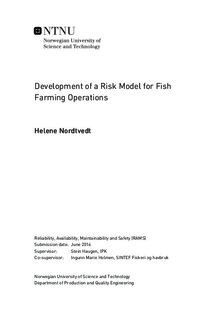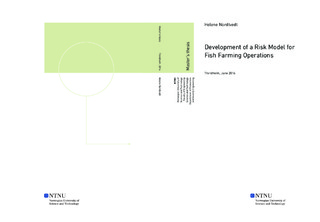| dc.description.abstract | Fish farming has grown to become one of Norway s largest export industries. By 2050, Norway has the potential of producing 50 million tons of fish each year, if challenges related to the production and environment are solved. This will be of invaluable importance with the growing population worldwide and challenges related to meeting the demand for food.
Fish farming facilities in Norway are gradually moving out from their origin in sheltered fjords to more exposed areas. This is due to the need for more space, as the facilities grow bigger, and better environment for production, as the current localities are related to challenges with fish diseases and accumulation of waste production in the proximity of the facilities.
Today s fish farming industry has developed high technological solutions and equipment to simplify the tough working environment. Still, several operations involve heavy manual labour and expose the workers to many hazards during a workday. Fish farming is Norway s second most dangerous occupation. Thus, the personal safety is an important aspect when working with development of the industry. It will be essential to ensure safe work places at existing and future fish farming facilities.
This research has considers the potential of a new risk model for fish farming operations. The development of the model is based on an approach called major accident risk indicators . The incentives for developing a new risk model for application in fish farming is the need for decision support systems and barriers against too hazardous work conditions. Usually, decisions related to whether to carry out an operation or not, are solely based on the experience of the workers, which may be affected by a tight schedule and other organisational factors. The idea is that this model will raise the awareness around the impact of influencing factors of hazardous events, thus motivating the workers to avoid working under too hazardous conditions.
Taking basis in a case operation, a potential approach for implementing the model is suggested. The main concept of the model is to identify unwanted events, and all relevant risk influencing factors. The relevant factors involve technical, human and organisational factors. The chosen factors are further modelled as Bayesian Networks, providing a useful illustration of all interconnections. All of the factors may have several potential states. By going through a checklist with statements working as indicators, the practitioners will be able to determine the factors state. Further, the aim is to be able to analyse the impact the factors different states will have on the risk of the hazardous event. This analysis is enabled using a conditional probability table.
The discussion is related to the potential application of the method. Necessary steps prior of a test period is considered as well as the model s limitations and the potential range of application. The main concern is related to the complexity and time-demand of implementing the model as well as the uncertainty it could include.
This research is not enough to base any final decision on whether or not the model is feasible in the context of fish farming. It does however provide motivation for further testing. This is recommended as further work, along with research on how to integrate the model as a software. The practitioners perception of the model should be investigated carefully as a part of evaluating the test period. | |

